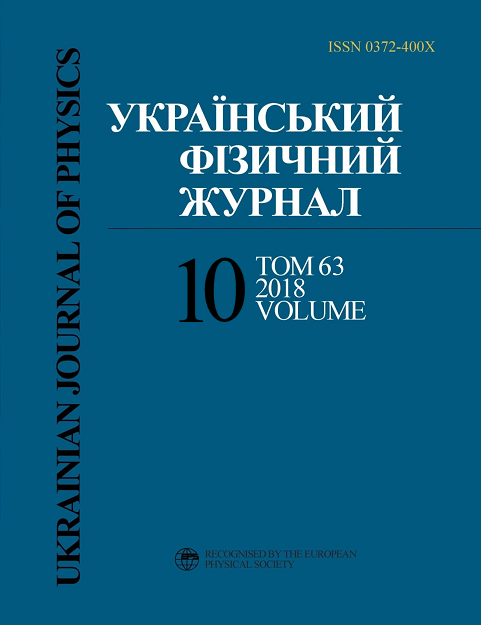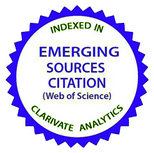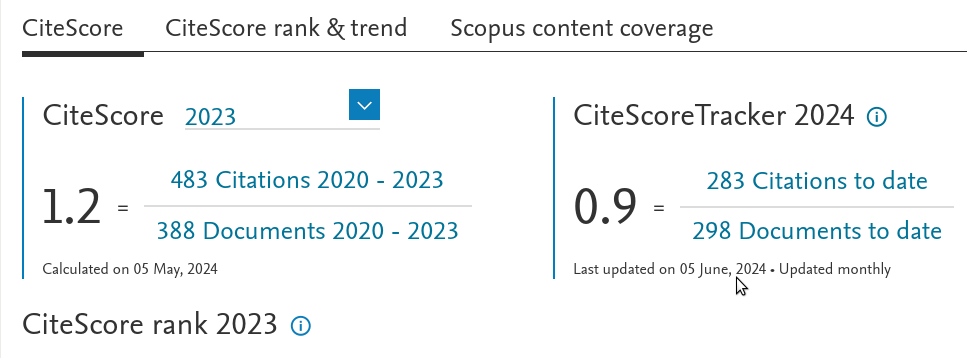Рівняння стану квантових газів поза рамками наближення Ван дер Ваальса
DOI:
https://doi.org/10.15407/ujpe63.10.863Ключові слова:
nuclear matter, hadron resonance gas, induced surface tension, quantum gases, virial coefficientsАнотація
Нещодавно запропоноване рiвняння стану з iндукованим поверхневим натягом узагальнено на випадок квантових газiв iз взаємодiєю середнього поля. Для такої моделi знайдено умови самоузгодженостi i умови необхiднi для виконання Третього Початку термодинамiки. На вiдмiну вiд традицiйних сподiвань показано, що внесення в тиск моделi Ван дер Ваальса третього i бiльш високих вiрiальних коефiцiєнтiв газу твердих сфер за низьких температур або порушує Третiй Початок термодинамiки, або не дозволяє вийти за рамки наближення Ван дер Ваальса. Продемонстровано, що узагальнене рiвняння стану з iндукованим поверхневим натягом дозволяє уникнути цих проблем i вийти за рамки наближення Ван дер Ваальса. Крiм цього отримано ефективне вiрiальне розкладання квантової версiї рiвняння стану з iндукованим натягом i його вiрiальнi коефiцiєнти знайдено точно. Явнi вирази для справжнiх квантових вiрiальних коефiцiєнтiв будь-якого порядку цього рiвняння стану подано в наближеннi низької густини. Обмiрковано деякi базовi умови на такi моделi, якi необхiднi для опису властивостей ядерної i адронної матерiй.
Посилання
J.D.Walecka. A theory of highly condensed matter. Annals Phys. 83, 491 (1974) .
https://doi.org/10.1016/0003-4916(74)90208-5
J. Zimanyi et al. An interpretable family of equations of state for dense hadronic matter. Nucl. Phys. A 484, 647 (1988).
https://doi.org/10.1016/0375-9474(88)90314-4
K.A. Bugaev, M.I. Gorenstein. Thermodynamically self-consistent class of nuclear matter EOS and compression shocks in relativistic nuclear collisions. Z. Phys. C 43, 261 (1989).
https://doi.org/10.1007/BF01588213
D.H. Rischke, M.I. Gorenstein, H. St¨ocker, W. Greiner. Excluded volume effect for the nuclear matter equation of state. Z. Phys. C 51, 485 (1991).
https://doi.org/10.1007/BF01548574
T.H.R. Skyrme. CVII. The nuclear surface. Phil. Mag. 1, 1043 (1956).
https://doi.org/10.1080/14786435608238186
T.H.R. Skyrme. The effective nuclear potential. Nucl. Phys. 9, 615 (1959).
https://doi.org/10.1016/0029-5582(58)90345-6
J.P. Hansen, I.R. McDonald. Theory of Simple Liquids (Academic, 2006).
L. Van Hove. Quelques proprietes generales de l'integrale de configuration D'un systeme de particules avec interaction. Physica 15, 951 (1949).
https://doi.org/10.1016/0031-8914(49)90059-2
L. Van Hove. Sur l'integrale de configuration pour les systemes de particules a une dimension. Physica 16, 137 (1950).
https://doi.org/10.1016/0031-8914(50)90072-3
M.I. Gorenstein, D.H. Rischke, H. St¨ocker, W. Greiner, K.A. Bugaev. A self-consistent equation of state for nuclear matter. J. Phys. G 19, L69 (1993).
V. Vovchenko, D.V. Anchishkin, M.I. Gorenstein. Van der Waals equation of state with Fermi statistics for nuclear matter. Phys. Rev. C 91, 064314 (2015).
https://doi.org/10.1103/PhysRevC.91.064314
K. Redlich, K. Zalewski. Thermodynamics of van der Waals fluids with quantum statistics. Acta Phys. Polon. B 47, 1943 (2016).
https://doi.org/10.5506/APhysPolB.47.1943
N.F. Carnahan, K.E. Starling. Equation of state for nonat-tracting rigid spheres. J. Chem. Phys. 51, 635 (1969).
https://doi.org/10.1063/1.1672048
K. Huang. Statistical Mechanics (Wiley, 1963). A. Andronic, P. Braun-Munzinger, J. Stachel. Hadron production in central nucleus–nucleus collisions at chemical freeze-out. Nucl. Phys. A 772, 167 (2006) and references therein.
https://doi.org/10.1016/j.nuclphysa.2006.03.012
K.A. Bugaev, D.R. Oliinychenko, A.S. Sorin, G.M. Zinovjev. Simple solution to the strangeness horn description puzzle. Eur. Phys. J. A 49, 30 (2013).
https://doi.org/10.1140/epja/i2013-13030-y
D.R. Oliinychenko, K.A. Bugaev, A.S. Sorin. Investigation of hadron multiplicities and hadron yield ratios in heavy ion collisions. Ukr. J. Phys. 58, 211 (2013).
https://doi.org/10.15407/ujpe58.03.0211
K.A. Bugaev et al. Chemical freeze-out of strange particles and possible root of strangeness suppression. Euro-phys. Lett. 104, 22002 (2013).
https://doi.org/10.1209/0295-5075/104/22002
J. Stachel, A. Andronic, P. Braun-Munzinger, K. Redlich. Confronting LHC data with the statistical hadronization model. J. Phys. Conf. Ser. 509, 012019 (2014) and references therein.
https://doi.org/10.1088/1742-6596/509/1/012019
V.V. Sagun. Λ-anomaly in the hadron chemical freeze-out. Ukr. J. Phys. 59, 755 (2014).
https://doi.org/10.15407/ujpe59.08.0755
K.A. Bugaev et al. Going beyond the second virial coefficient in the hadron resonance gas mode. Nucl. Phys. A 970, 133 (2018).
https://doi.org/10.1016/j.nuclphysa.2017.11.008
V.V. Sagun et al. Hadron resonance gas model with induced surface tension. Eur. Phys. J. A 54, 100 (2018).
https://doi.org/10.1140/epja/i2018-12535-1
K.A. Bugaev et al. Threshold collision energy of the QCD phase diagram tricritical endpoint. Phys. Part. Nucl. Lett. 15, 210 (2018).
https://doi.org/10.1134/S1547477118030068
V.V. Sagun, K.A. Bugaev, A.I. Ivanytskyi, I.N. Mishustin. The statistical multifragmentation model for liquid–gas phase transition with a compressible nuclear liquid. Nucl. Phys. A 924, 24 (2014).
https://doi.org/10.1016/j.nuclphysa.2013.12.012
K.A. Bugaev, M.I. Gorenstein, I.N. Mishustin, W. Greiner. Exactly soluble model for nuclear liquid-gas phase transition. Phys. Rev. C 62, 044320 (2000).
https://doi.org/10.1103/PhysRevC.62.044320
J.P. Bondorf et al. Statistical multifragmentation of nuclei. Phys. Rep. 257, 131 (1995).
https://doi.org/10.1016/0370-1573(94)00097-M
A. Kostyuk, M.I. Gorenstein, H. St¨ocker, W. Greiner. Second cluster integral and excluded volume effects for the pion gas. Phys. Rev. C 63, 044901 (2001).
https://doi.org/10.1103/PhysRevC.63.044901
J. Kolafa, M. Rottner. Simulation-based equation of state of the hard disk fluid and prediction of higher-order virial coefficients. Mol. Phys. 104, 3435 (2006).
https://doi.org/10.1080/00268970600967963
B. Barboy, W.M. Gelbart. Series representation of the equation of state for hard particle fluids. J. Chem. Phys. 71, 3053 (1979).
https://doi.org/10.1063/1.438711
S. Typel. Variations on the excluded-volume mechanism. Eur. Phys. J. A 52, 16 (2016).
https://doi.org/10.1140/epja/i2016-16016-3
A.I. Ivanytskyi, K.A. Bugaev, V.V. Sagun, L.V. Bravina, E.E. Zabrodin. Influence of flow constraint on the properties of nuclear matter critical endpoint. Phys. Rev. C 97, 064905 (2018).
https://doi.org/10.1103/PhysRevC.97.064905
K.A. Bugaev. The Van-der-Waals gas EOS for the Lorentz contracted spheres. Nucl. Phys. A 807, 251 (2008) and references therein.
https://doi.org/10.1016/j.nuclphysa.2008.04.007
V. Vovchenko. Equations of state for real gases on the nuclear scale. Phys. Rev. C 96, 015206 (2017).
https://doi.org/10.1103/PhysRevC.96.015206
P. Danielewicz, R. Lacey, W.G. Lynch. Determination of the equation of state of dense matter. Science 298, 1592 (2002).
https://doi.org/10.1126/science.1078070
M. Dutra et al. Relativistic mean-field hadronic models under nuclear matter constraints. Phys. Rev. C 90, 055203 (2014) and references therein.
https://doi.org/10.1103/PhysRevC.90.055203
O. Lourenco, M. Dutra, D.P. Menezes. Critical parameters of consistent relativistic mean-field models. Phys. Rev. C 95, 065212 (2017).
https://doi.org/10.1103/PhysRevC.95.065212
V.V. Sagun, I. Lopes. Neutron stars: A novel equation of state with induced surface tension. Astrophys. J 850, 75 (2017).
https://doi.org/10.3847/1538-4357/aa92cf
R. Venugopalan, M. Prakash. Thermal properties of interacting hadrons. Nucl. Phys. A 546, 718 (1992).
https://doi.org/10.1016/0375-9474(92)90005-5
L.M. Satarov, M.N. Dmitriev, I.N. Mishustin. Equation of state of hadron resonance gas and the phase diagram of strongly interacting matter. Phys. Atom. Nucl. 72, 1390 (2009).
https://doi.org/10.1134/S1063778809080146
K.A. Bugaev. Shock-like freeze-out in relativistic hydrodynamics. Nucl. Phys. A 606, 559 (1996).
https://doi.org/10.1016/0375-9474(96)00189-3
K.A. Bugaev. Relativistic kinetic equations for finite domains and freeze-out problem. Phys. Rev. Lett. 90, 252301 (2003) and references therein.
https://doi.org/10.1103/PhysRevLett.90.252301
L.M. Satarov, K.A. Bugaev, I.N. Mishustin. Equation of state and sound velocity of a hadronic gas with a hard-core interaction. Phys. Rev. C 91, 055203 (2015).
https://doi.org/10.1103/PhysRevC.91.055203
N. Agrawal et. al. Probing the hadronic phase with resonances of different life-times in Pb-Pb collisions with ALICE. [ALICE Collaboration] arXiv:1711.02408v1 [hep-ex].
L. Adamczyk et al. [STAR Collaboration] Probing parton dynamics of QCD matter with Ω and ф production. Phys. Rev. C 93, 021903 (2016).
https://doi.org/10.1103/PhysRevC.93.021903
D. Rischke. Exploring strongly interacting matter at high densities – NICA white paper. Eur. Phys. J. A 52, 267 (2016).
https://doi.org/10.1140/epja/i2016-16267-x
P. Senger. Nuclear matter physics at NICA. Eur. Phys. J. A 52, 217 (2016).
https://doi.org/10.1140/epja/i2016-16217-8
P. Senger. The compressed baryon matter experiment at FAIR. Nucl. Phys. A 862–863, 139 (2011).
https://doi.org/10.1016/j.nuclphysa.2011.05.032
T. Ablyazimov et al. Challenges in QCD matter physics – the scientific programme of the Compressed Baryon Matter experiment at FAIR. Eur. Phys. J. A 53, 60 (2017).
Downloads
Опубліковано
Як цитувати
Номер
Розділ
Ліцензія
Ліцензійний Договір
на використання Твору
м. Київ, Україна
Відповідальний автор та співавтори (надалі іменовані як Автор(и)) статті, яку він (вони) подають до Українського фізичного журналу, (надалі іменована як Твір) з одного боку та Інститут теоретичної фізики імені М.М. Боголюбова НАН України в особі директора (надалі – Видавець) з іншого боку уклали даний Договір про таке:
1. Предмет договору.
Автор(и) надає(ють) Видавцю безоплатно невиключні права на використання Твору (наукового, технічного або іншого характеру) на умовах, визначених цим Договором.
2. Способи використання Твору.
2.1. Автор(и) надає(ють) Видавцю право на використання Твору таким чином:
2.1.1. Використовувати Твір шляхом його видання в Українському фізичному журналі (далі – Видання) мовою оригіналу та в перекладі на англійську (погоджений Автором(ами) і Видавцем примірник Твору, прийнятого до друку, є невід’ємною частиною Ліцензійного договору).
2.1.2. Переробляти, адаптувати або іншим чином змінювати Твір за погодженням з Автором(ами).
2.1.3. Перекладати Твір у випадку, коли Твір викладений іншою мовою, ніж мова, якою передбачена публікація у Виданні.
2.2. Якщо Автор(и) виявить(лять) бажання використовувати Твір в інший спосіб, як то публікувати перекладену версію Твору (окрім випадку, зазначеного в п. 2.1.3 цього Договору); розміщувати повністю або частково в мережі Інтернет; публікувати Твір в інших, у тому числі іноземних, виданнях; включати Твір як складову частину інших збірників, антологій, енциклопедій тощо, то Автор(и) мають отримати на це письмовий дозвіл від Видавця.
3. Територія використання.
Автор(и) надає(ють) Видавцю право на використання Твору способами, зазначеними у п.п. 2.1.1–2.1.3 цього Договору, на території України, а також право на розповсюдження Твору як невід’ємної складової частини Видання на території України та інших країн шляхом передплати, продажу та безоплатної передачі третій стороні.
4. Строк, на який надаються права.
4.1. Договір є чинним з дати підписання та діє протягом усього часу функціонування Видання.
5. Застереження.
5.1. Автор(и) заявляє(ють), що:
– він/вона є автором (співавтором) Твору;
– авторські права на даний Твір не передані іншій стороні;
– даний Твір не був раніше опублікований і не буде опублікований у будь-якому іншому виданні до публікації його Видавцем (див. також п. 2.2);
– Автор(и) не порушив(ли) права інтелектуальної власності інших осіб. Якщо у Творі наведені матеріали інших осіб за виключенням випадків цитування в обсязі, виправданому науковим, інформаційним або критичним характером Твору, використання таких матеріалів здійснене Автором(ами) з дотриманням норм міжнародного законодавства і законодавства України.
6. Реквізити і підписи сторін.
Видавець: Інститут теоретичної фізики імені М.М. Боголюбова НАН України.
Адреса: м. Київ, вул. Метрологічна 14-б.
Автор: Електронний підпис від імені та за погодження всіх співавторів.

















